Information Technology Impact on Marriott International - HC1041
VerifiedAdded on 2023/04/03
|9
|2072
|234
Report
AI Summary
This report examines the impact of Information Technology (IT) on Marriott International, a global hospitality company. It highlights the relevance and importance of IT in enhancing efficiency, customer relations, and overall business operations. The report discusses the requirements for applying IT, including planning, cost-effectiveness analysis, and adaptability. It explores the use of IT in improving communication with customers, offering online services, and integrating various business functions through an Integrated Management Information System (IMIS). The advantages of IT, such as increased availability of services, competitive advantage, improved production, and cost savings, are detailed. The report also addresses the risks associated with IT, particularly information security breaches, privacy violations, and cyber attacks, referencing the Starwood guest reservation data breach as a case study. Finally, it outlines the importance of maintenance and monitoring of IT systems, including corrective, preventive, perfective, and adaptive maintenance, along with security measures like firewalls and intrusion detection systems. The report concludes that while IT offers significant benefits, effective risk management and continuous system modification are crucial for mitigating potential threats and ensuring business evolution.
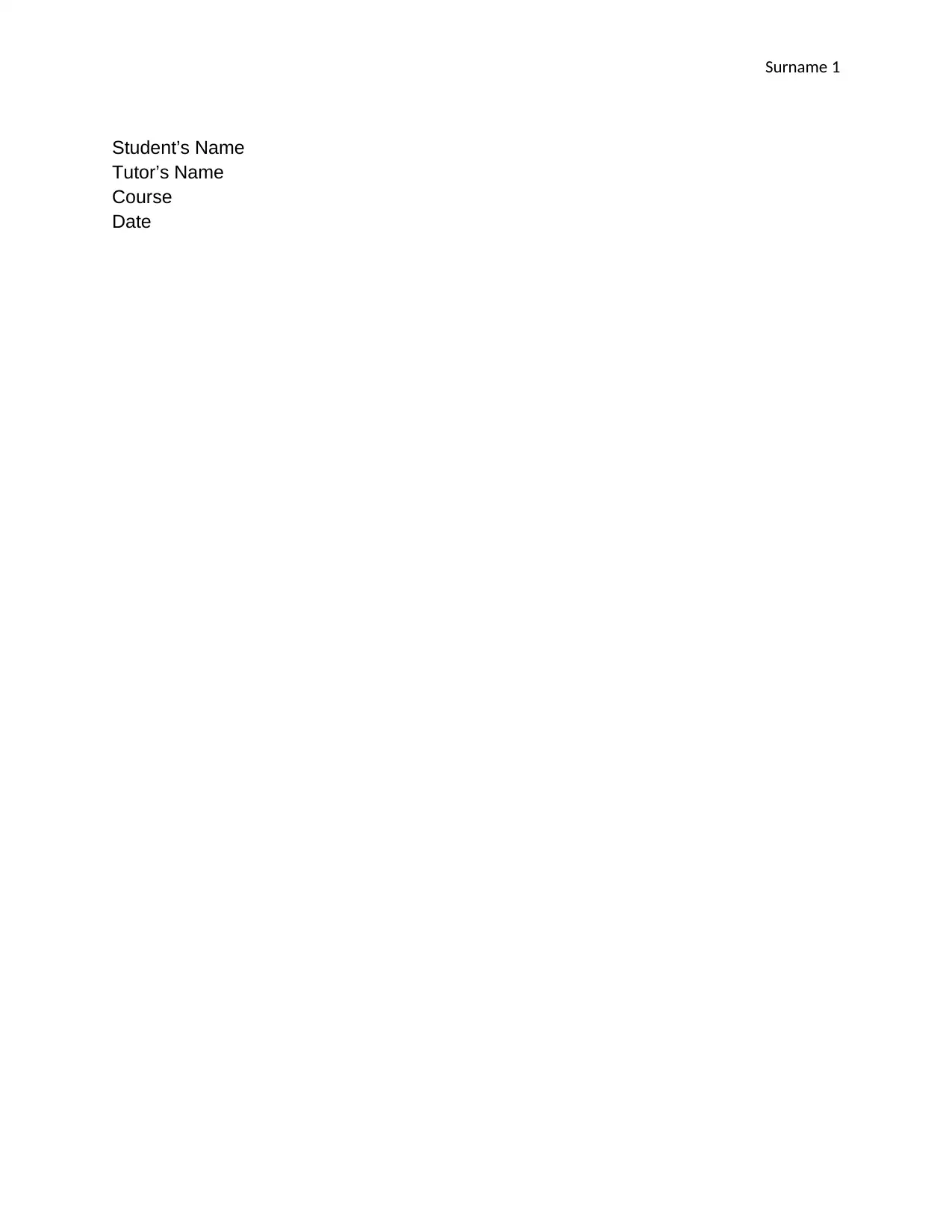
Surname 1
Student’s Name
Tutor’s Name
Course
Date
Student’s Name
Tutor’s Name
Course
Date
Paraphrase This Document
Need a fresh take? Get an instant paraphrase of this document with our AI Paraphraser
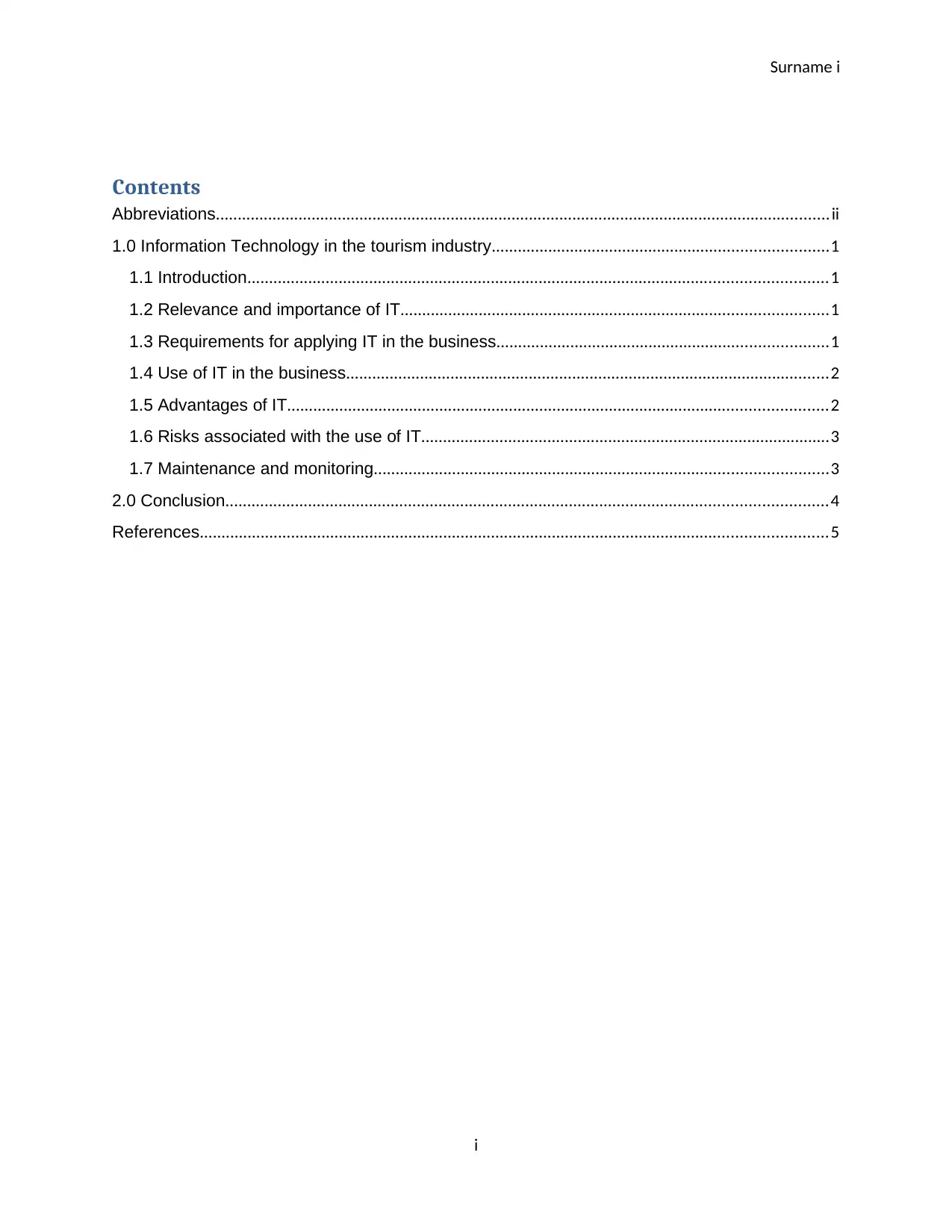
Surname i
Contents
Abbreviations.............................................................................................................................................ii
1.0 Information Technology in the tourism industry.............................................................................1
1.1 Introduction.....................................................................................................................................1
1.2 Relevance and importance of IT..................................................................................................1
1.3 Requirements for applying IT in the business............................................................................1
1.4 Use of IT in the business...............................................................................................................2
1.5 Advantages of IT............................................................................................................................2
1.6 Risks associated with the use of IT..............................................................................................3
1.7 Maintenance and monitoring........................................................................................................3
2.0 Conclusion..........................................................................................................................................4
References................................................................................................................................................5
i
Contents
Abbreviations.............................................................................................................................................ii
1.0 Information Technology in the tourism industry.............................................................................1
1.1 Introduction.....................................................................................................................................1
1.2 Relevance and importance of IT..................................................................................................1
1.3 Requirements for applying IT in the business............................................................................1
1.4 Use of IT in the business...............................................................................................................2
1.5 Advantages of IT............................................................................................................................2
1.6 Risks associated with the use of IT..............................................................................................3
1.7 Maintenance and monitoring........................................................................................................3
2.0 Conclusion..........................................................................................................................................4
References................................................................................................................................................5
i
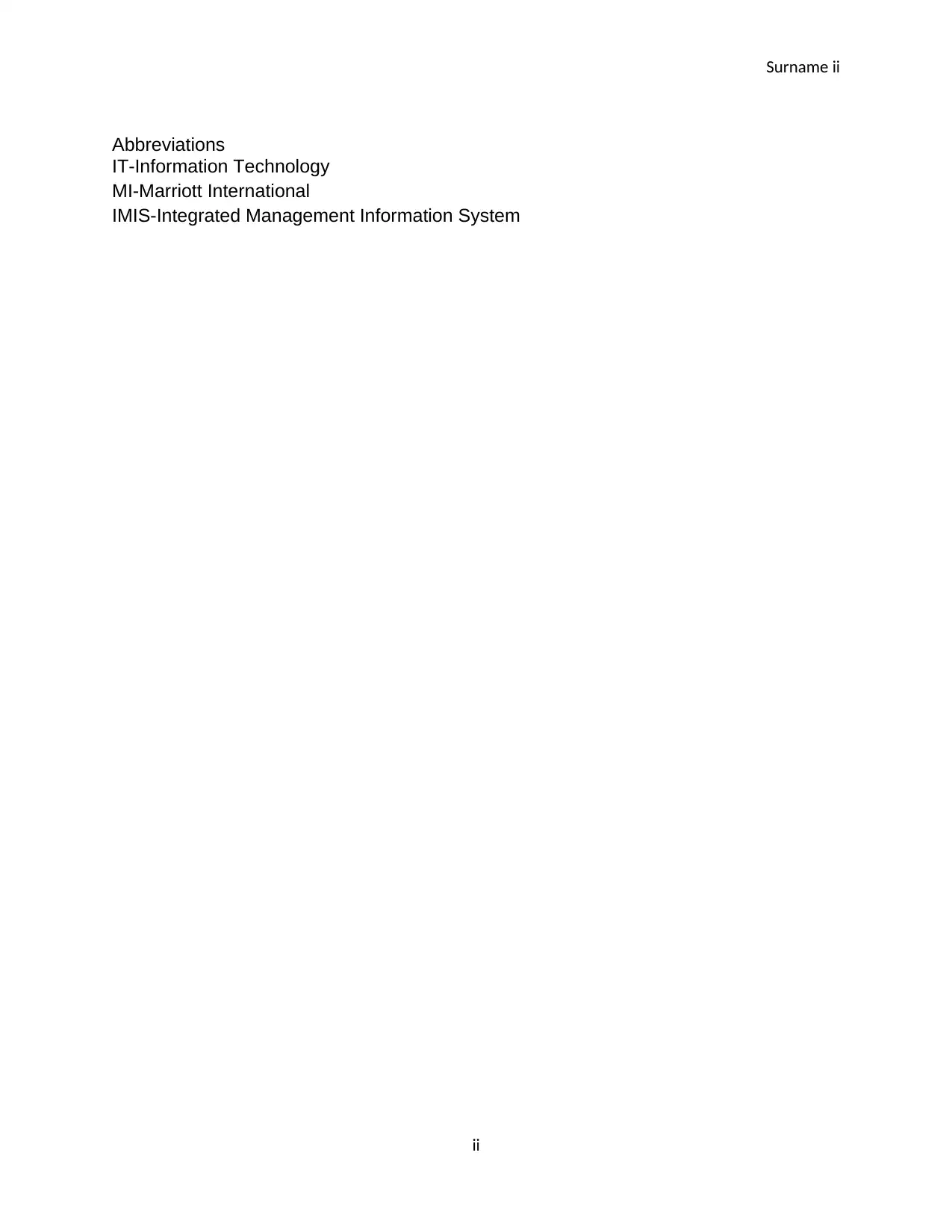
Surname ii
Abbreviations
IT-Information Technology
MI-Marriott International
IMIS-Integrated Management Information System
ii
Abbreviations
IT-Information Technology
MI-Marriott International
IMIS-Integrated Management Information System
ii
⊘ This is a preview!⊘
Do you want full access?
Subscribe today to unlock all pages.

Trusted by 1+ million students worldwide
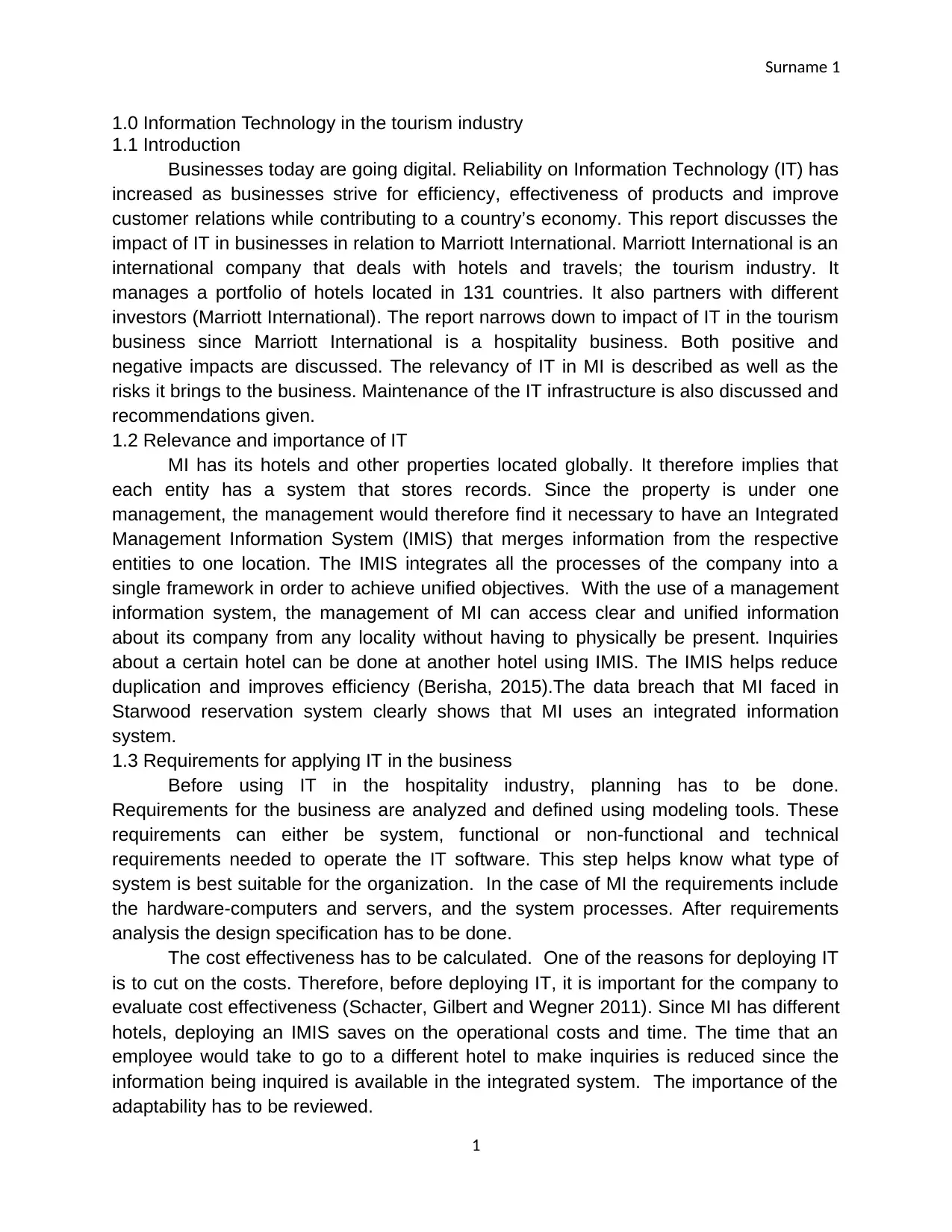
Surname 1
1.0 Information Technology in the tourism industry
1.1 Introduction
Businesses today are going digital. Reliability on Information Technology (IT) has
increased as businesses strive for efficiency, effectiveness of products and improve
customer relations while contributing to a country’s economy. This report discusses the
impact of IT in businesses in relation to Marriott International. Marriott International is an
international company that deals with hotels and travels; the tourism industry. It
manages a portfolio of hotels located in 131 countries. It also partners with different
investors (Marriott International). The report narrows down to impact of IT in the tourism
business since Marriott International is a hospitality business. Both positive and
negative impacts are discussed. The relevancy of IT in MI is described as well as the
risks it brings to the business. Maintenance of the IT infrastructure is also discussed and
recommendations given.
1.2 Relevance and importance of IT
MI has its hotels and other properties located globally. It therefore implies that
each entity has a system that stores records. Since the property is under one
management, the management would therefore find it necessary to have an Integrated
Management Information System (IMIS) that merges information from the respective
entities to one location. The IMIS integrates all the processes of the company into a
single framework in order to achieve unified objectives. With the use of a management
information system, the management of MI can access clear and unified information
about its company from any locality without having to physically be present. Inquiries
about a certain hotel can be done at another hotel using IMIS. The IMIS helps reduce
duplication and improves efficiency (Berisha, 2015).The data breach that MI faced in
Starwood reservation system clearly shows that MI uses an integrated information
system.
1.3 Requirements for applying IT in the business
Before using IT in the hospitality industry, planning has to be done.
Requirements for the business are analyzed and defined using modeling tools. These
requirements can either be system, functional or non-functional and technical
requirements needed to operate the IT software. This step helps know what type of
system is best suitable for the organization. In the case of MI the requirements include
the hardware-computers and servers, and the system processes. After requirements
analysis the design specification has to be done.
The cost effectiveness has to be calculated. One of the reasons for deploying IT
is to cut on the costs. Therefore, before deploying IT, it is important for the company to
evaluate cost effectiveness (Schacter, Gilbert and Wegner 2011). Since MI has different
hotels, deploying an IMIS saves on the operational costs and time. The time that an
employee would take to go to a different hotel to make inquiries is reduced since the
information being inquired is available in the integrated system. The importance of the
adaptability has to be reviewed.
1
1.0 Information Technology in the tourism industry
1.1 Introduction
Businesses today are going digital. Reliability on Information Technology (IT) has
increased as businesses strive for efficiency, effectiveness of products and improve
customer relations while contributing to a country’s economy. This report discusses the
impact of IT in businesses in relation to Marriott International. Marriott International is an
international company that deals with hotels and travels; the tourism industry. It
manages a portfolio of hotels located in 131 countries. It also partners with different
investors (Marriott International). The report narrows down to impact of IT in the tourism
business since Marriott International is a hospitality business. Both positive and
negative impacts are discussed. The relevancy of IT in MI is described as well as the
risks it brings to the business. Maintenance of the IT infrastructure is also discussed and
recommendations given.
1.2 Relevance and importance of IT
MI has its hotels and other properties located globally. It therefore implies that
each entity has a system that stores records. Since the property is under one
management, the management would therefore find it necessary to have an Integrated
Management Information System (IMIS) that merges information from the respective
entities to one location. The IMIS integrates all the processes of the company into a
single framework in order to achieve unified objectives. With the use of a management
information system, the management of MI can access clear and unified information
about its company from any locality without having to physically be present. Inquiries
about a certain hotel can be done at another hotel using IMIS. The IMIS helps reduce
duplication and improves efficiency (Berisha, 2015).The data breach that MI faced in
Starwood reservation system clearly shows that MI uses an integrated information
system.
1.3 Requirements for applying IT in the business
Before using IT in the hospitality industry, planning has to be done.
Requirements for the business are analyzed and defined using modeling tools. These
requirements can either be system, functional or non-functional and technical
requirements needed to operate the IT software. This step helps know what type of
system is best suitable for the organization. In the case of MI the requirements include
the hardware-computers and servers, and the system processes. After requirements
analysis the design specification has to be done.
The cost effectiveness has to be calculated. One of the reasons for deploying IT
is to cut on the costs. Therefore, before deploying IT, it is important for the company to
evaluate cost effectiveness (Schacter, Gilbert and Wegner 2011). Since MI has different
hotels, deploying an IMIS saves on the operational costs and time. The time that an
employee would take to go to a different hotel to make inquiries is reduced since the
information being inquired is available in the integrated system. The importance of the
adaptability has to be reviewed.
1
Paraphrase This Document
Need a fresh take? Get an instant paraphrase of this document with our AI Paraphraser
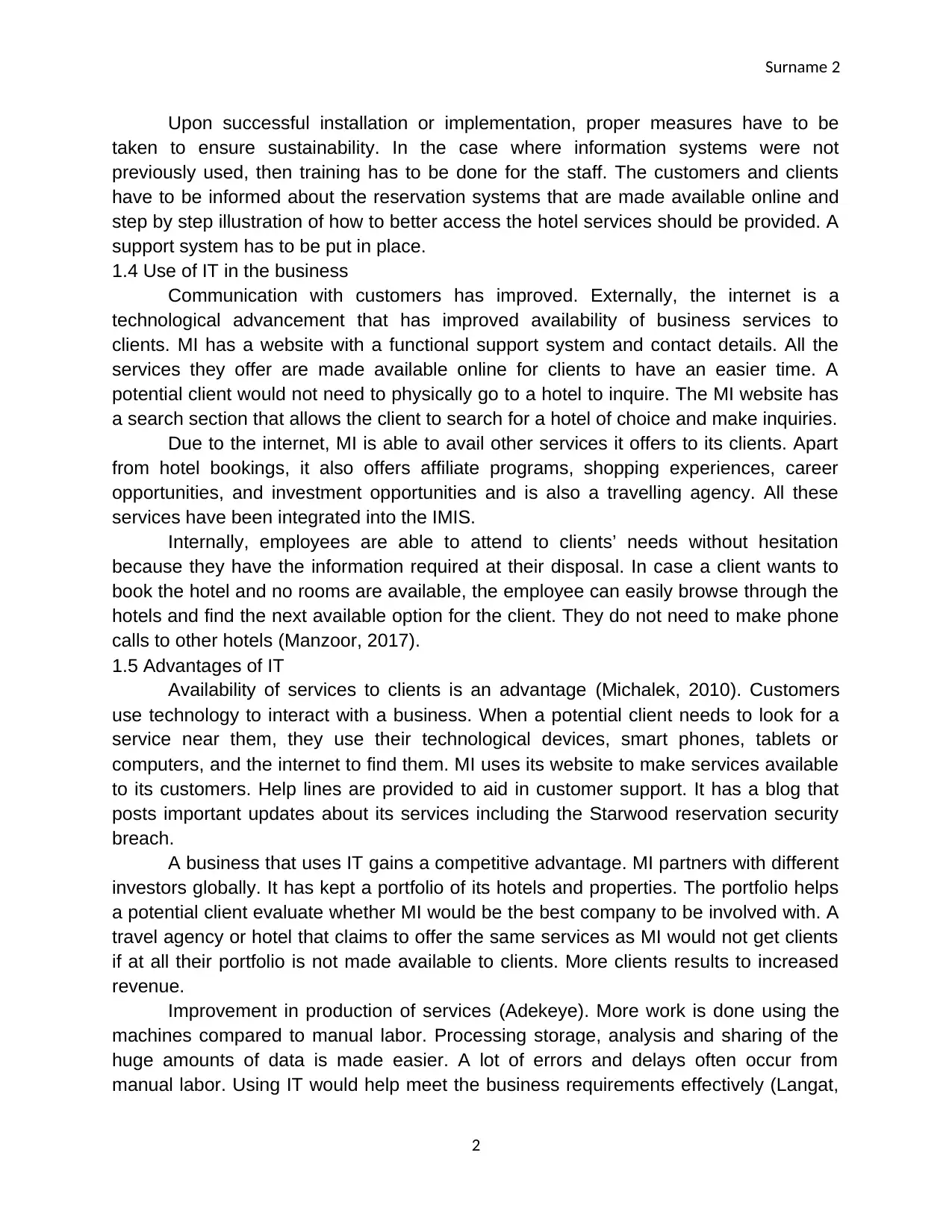
Surname 2
Upon successful installation or implementation, proper measures have to be
taken to ensure sustainability. In the case where information systems were not
previously used, then training has to be done for the staff. The customers and clients
have to be informed about the reservation systems that are made available online and
step by step illustration of how to better access the hotel services should be provided. A
support system has to be put in place.
1.4 Use of IT in the business
Communication with customers has improved. Externally, the internet is a
technological advancement that has improved availability of business services to
clients. MI has a website with a functional support system and contact details. All the
services they offer are made available online for clients to have an easier time. A
potential client would not need to physically go to a hotel to inquire. The MI website has
a search section that allows the client to search for a hotel of choice and make inquiries.
Due to the internet, MI is able to avail other services it offers to its clients. Apart
from hotel bookings, it also offers affiliate programs, shopping experiences, career
opportunities, and investment opportunities and is also a travelling agency. All these
services have been integrated into the IMIS.
Internally, employees are able to attend to clients’ needs without hesitation
because they have the information required at their disposal. In case a client wants to
book the hotel and no rooms are available, the employee can easily browse through the
hotels and find the next available option for the client. They do not need to make phone
calls to other hotels (Manzoor, 2017).
1.5 Advantages of IT
Availability of services to clients is an advantage (Michalek, 2010). Customers
use technology to interact with a business. When a potential client needs to look for a
service near them, they use their technological devices, smart phones, tablets or
computers, and the internet to find them. MI uses its website to make services available
to its customers. Help lines are provided to aid in customer support. It has a blog that
posts important updates about its services including the Starwood reservation security
breach.
A business that uses IT gains a competitive advantage. MI partners with different
investors globally. It has kept a portfolio of its hotels and properties. The portfolio helps
a potential client evaluate whether MI would be the best company to be involved with. A
travel agency or hotel that claims to offer the same services as MI would not get clients
if at all their portfolio is not made available to clients. More clients results to increased
revenue.
Improvement in production of services (Adekeye). More work is done using the
machines compared to manual labor. Processing storage, analysis and sharing of the
huge amounts of data is made easier. A lot of errors and delays often occur from
manual labor. Using IT would help meet the business requirements effectively (Langat,
2
Upon successful installation or implementation, proper measures have to be
taken to ensure sustainability. In the case where information systems were not
previously used, then training has to be done for the staff. The customers and clients
have to be informed about the reservation systems that are made available online and
step by step illustration of how to better access the hotel services should be provided. A
support system has to be put in place.
1.4 Use of IT in the business
Communication with customers has improved. Externally, the internet is a
technological advancement that has improved availability of business services to
clients. MI has a website with a functional support system and contact details. All the
services they offer are made available online for clients to have an easier time. A
potential client would not need to physically go to a hotel to inquire. The MI website has
a search section that allows the client to search for a hotel of choice and make inquiries.
Due to the internet, MI is able to avail other services it offers to its clients. Apart
from hotel bookings, it also offers affiliate programs, shopping experiences, career
opportunities, and investment opportunities and is also a travelling agency. All these
services have been integrated into the IMIS.
Internally, employees are able to attend to clients’ needs without hesitation
because they have the information required at their disposal. In case a client wants to
book the hotel and no rooms are available, the employee can easily browse through the
hotels and find the next available option for the client. They do not need to make phone
calls to other hotels (Manzoor, 2017).
1.5 Advantages of IT
Availability of services to clients is an advantage (Michalek, 2010). Customers
use technology to interact with a business. When a potential client needs to look for a
service near them, they use their technological devices, smart phones, tablets or
computers, and the internet to find them. MI uses its website to make services available
to its customers. Help lines are provided to aid in customer support. It has a blog that
posts important updates about its services including the Starwood reservation security
breach.
A business that uses IT gains a competitive advantage. MI partners with different
investors globally. It has kept a portfolio of its hotels and properties. The portfolio helps
a potential client evaluate whether MI would be the best company to be involved with. A
travel agency or hotel that claims to offer the same services as MI would not get clients
if at all their portfolio is not made available to clients. More clients results to increased
revenue.
Improvement in production of services (Adekeye). More work is done using the
machines compared to manual labor. Processing storage, analysis and sharing of the
huge amounts of data is made easier. A lot of errors and delays often occur from
manual labor. Using IT would help meet the business requirements effectively (Langat,
2
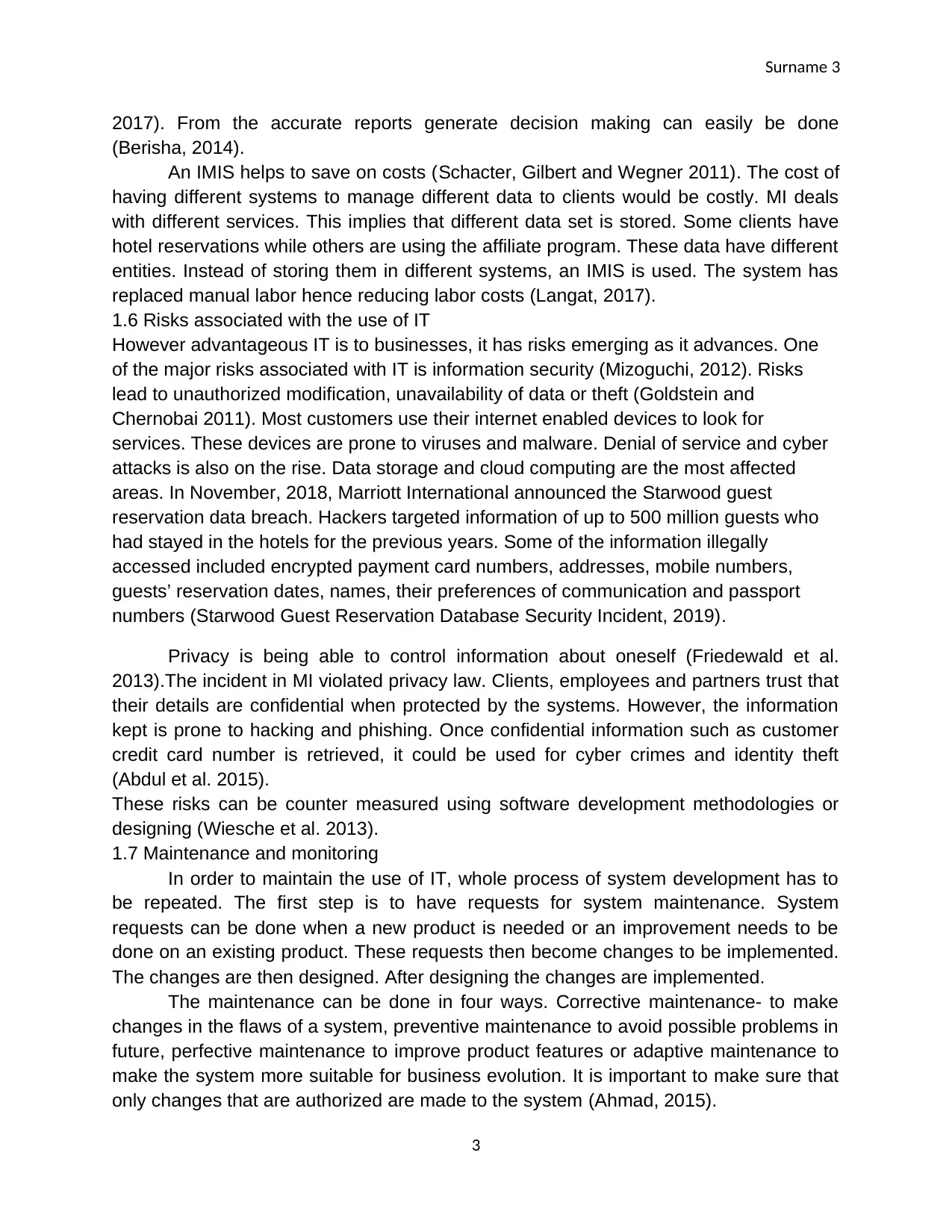
Surname 3
2017). From the accurate reports generate decision making can easily be done
(Berisha, 2014).
An IMIS helps to save on costs (Schacter, Gilbert and Wegner 2011). The cost of
having different systems to manage different data to clients would be costly. MI deals
with different services. This implies that different data set is stored. Some clients have
hotel reservations while others are using the affiliate program. These data have different
entities. Instead of storing them in different systems, an IMIS is used. The system has
replaced manual labor hence reducing labor costs (Langat, 2017).
1.6 Risks associated with the use of IT
However advantageous IT is to businesses, it has risks emerging as it advances. One
of the major risks associated with IT is information security (Mizoguchi, 2012). Risks
lead to unauthorized modification, unavailability of data or theft (Goldstein and
Chernobai 2011). Most customers use their internet enabled devices to look for
services. These devices are prone to viruses and malware. Denial of service and cyber
attacks is also on the rise. Data storage and cloud computing are the most affected
areas. In November, 2018, Marriott International announced the Starwood guest
reservation data breach. Hackers targeted information of up to 500 million guests who
had stayed in the hotels for the previous years. Some of the information illegally
accessed included encrypted payment card numbers, addresses, mobile numbers,
guests’ reservation dates, names, their preferences of communication and passport
numbers (Starwood Guest Reservation Database Security Incident, 2019).
Privacy is being able to control information about oneself (Friedewald et al.
2013).The incident in MI violated privacy law. Clients, employees and partners trust that
their details are confidential when protected by the systems. However, the information
kept is prone to hacking and phishing. Once confidential information such as customer
credit card number is retrieved, it could be used for cyber crimes and identity theft
(Abdul et al. 2015).
These risks can be counter measured using software development methodologies or
designing (Wiesche et al. 2013).
1.7 Maintenance and monitoring
In order to maintain the use of IT, whole process of system development has to
be repeated. The first step is to have requests for system maintenance. System
requests can be done when a new product is needed or an improvement needs to be
done on an existing product. These requests then become changes to be implemented.
The changes are then designed. After designing the changes are implemented.
The maintenance can be done in four ways. Corrective maintenance- to make
changes in the flaws of a system, preventive maintenance to avoid possible problems in
future, perfective maintenance to improve product features or adaptive maintenance to
make the system more suitable for business evolution. It is important to make sure that
only changes that are authorized are made to the system (Ahmad, 2015).
3
2017). From the accurate reports generate decision making can easily be done
(Berisha, 2014).
An IMIS helps to save on costs (Schacter, Gilbert and Wegner 2011). The cost of
having different systems to manage different data to clients would be costly. MI deals
with different services. This implies that different data set is stored. Some clients have
hotel reservations while others are using the affiliate program. These data have different
entities. Instead of storing them in different systems, an IMIS is used. The system has
replaced manual labor hence reducing labor costs (Langat, 2017).
1.6 Risks associated with the use of IT
However advantageous IT is to businesses, it has risks emerging as it advances. One
of the major risks associated with IT is information security (Mizoguchi, 2012). Risks
lead to unauthorized modification, unavailability of data or theft (Goldstein and
Chernobai 2011). Most customers use their internet enabled devices to look for
services. These devices are prone to viruses and malware. Denial of service and cyber
attacks is also on the rise. Data storage and cloud computing are the most affected
areas. In November, 2018, Marriott International announced the Starwood guest
reservation data breach. Hackers targeted information of up to 500 million guests who
had stayed in the hotels for the previous years. Some of the information illegally
accessed included encrypted payment card numbers, addresses, mobile numbers,
guests’ reservation dates, names, their preferences of communication and passport
numbers (Starwood Guest Reservation Database Security Incident, 2019).
Privacy is being able to control information about oneself (Friedewald et al.
2013).The incident in MI violated privacy law. Clients, employees and partners trust that
their details are confidential when protected by the systems. However, the information
kept is prone to hacking and phishing. Once confidential information such as customer
credit card number is retrieved, it could be used for cyber crimes and identity theft
(Abdul et al. 2015).
These risks can be counter measured using software development methodologies or
designing (Wiesche et al. 2013).
1.7 Maintenance and monitoring
In order to maintain the use of IT, whole process of system development has to
be repeated. The first step is to have requests for system maintenance. System
requests can be done when a new product is needed or an improvement needs to be
done on an existing product. These requests then become changes to be implemented.
The changes are then designed. After designing the changes are implemented.
The maintenance can be done in four ways. Corrective maintenance- to make
changes in the flaws of a system, preventive maintenance to avoid possible problems in
future, perfective maintenance to improve product features or adaptive maintenance to
make the system more suitable for business evolution. It is important to make sure that
only changes that are authorized are made to the system (Ahmad, 2015).
3
⊘ This is a preview!⊘
Do you want full access?
Subscribe today to unlock all pages.

Trusted by 1+ million students worldwide
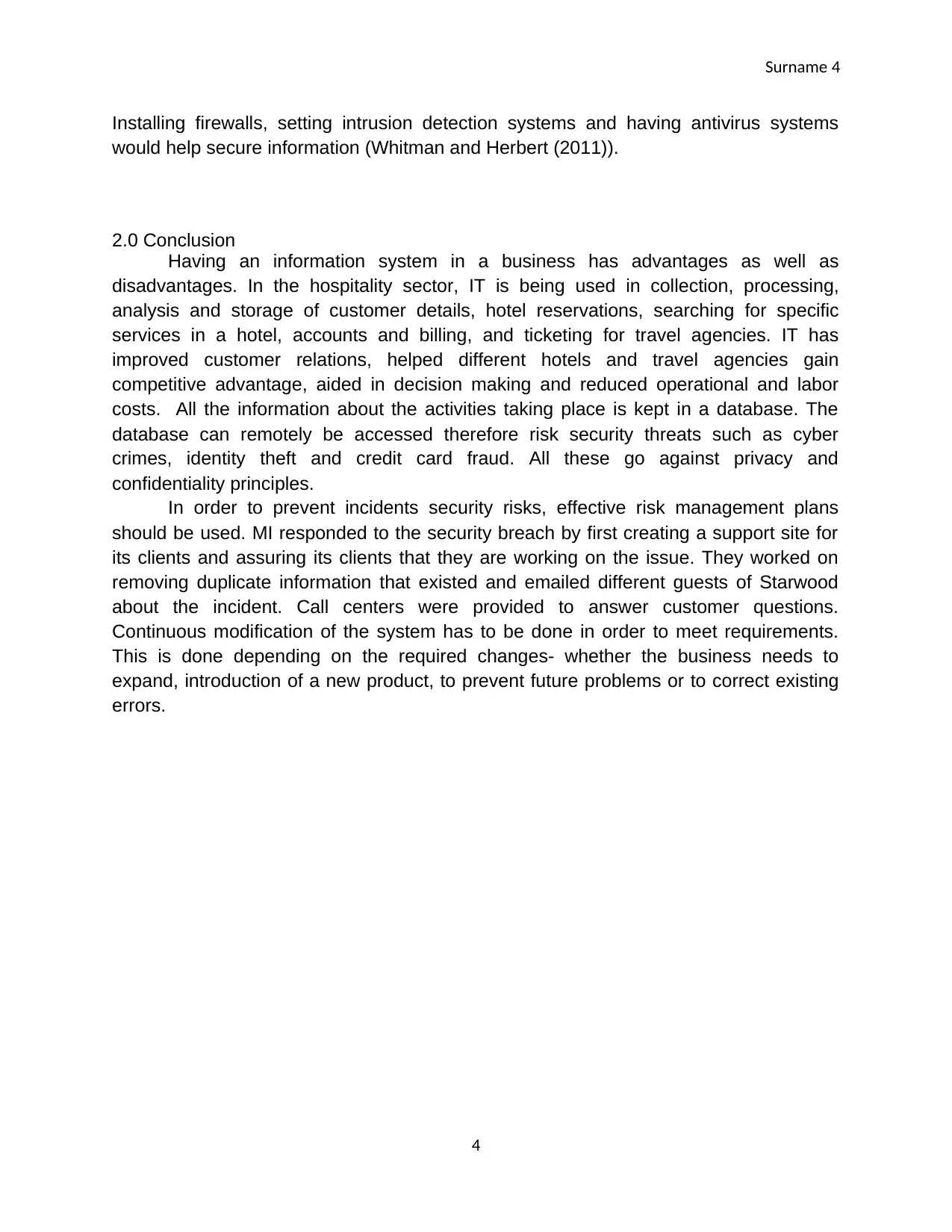
Surname 4
Installing firewalls, setting intrusion detection systems and having antivirus systems
would help secure information (Whitman and Herbert (2011)).
2.0 Conclusion
Having an information system in a business has advantages as well as
disadvantages. In the hospitality sector, IT is being used in collection, processing,
analysis and storage of customer details, hotel reservations, searching for specific
services in a hotel, accounts and billing, and ticketing for travel agencies. IT has
improved customer relations, helped different hotels and travel agencies gain
competitive advantage, aided in decision making and reduced operational and labor
costs. All the information about the activities taking place is kept in a database. The
database can remotely be accessed therefore risk security threats such as cyber
crimes, identity theft and credit card fraud. All these go against privacy and
confidentiality principles.
In order to prevent incidents security risks, effective risk management plans
should be used. MI responded to the security breach by first creating a support site for
its clients and assuring its clients that they are working on the issue. They worked on
removing duplicate information that existed and emailed different guests of Starwood
about the incident. Call centers were provided to answer customer questions.
Continuous modification of the system has to be done in order to meet requirements.
This is done depending on the required changes- whether the business needs to
expand, introduction of a new product, to prevent future problems or to correct existing
errors.
4
Installing firewalls, setting intrusion detection systems and having antivirus systems
would help secure information (Whitman and Herbert (2011)).
2.0 Conclusion
Having an information system in a business has advantages as well as
disadvantages. In the hospitality sector, IT is being used in collection, processing,
analysis and storage of customer details, hotel reservations, searching for specific
services in a hotel, accounts and billing, and ticketing for travel agencies. IT has
improved customer relations, helped different hotels and travel agencies gain
competitive advantage, aided in decision making and reduced operational and labor
costs. All the information about the activities taking place is kept in a database. The
database can remotely be accessed therefore risk security threats such as cyber
crimes, identity theft and credit card fraud. All these go against privacy and
confidentiality principles.
In order to prevent incidents security risks, effective risk management plans
should be used. MI responded to the security breach by first creating a support site for
its clients and assuring its clients that they are working on the issue. They worked on
removing duplicate information that existed and emailed different guests of Starwood
about the incident. Call centers were provided to answer customer questions.
Continuous modification of the system has to be done in order to meet requirements.
This is done depending on the required changes- whether the business needs to
expand, introduction of a new product, to prevent future problems or to correct existing
errors.
4
Paraphrase This Document
Need a fresh take? Get an instant paraphrase of this document with our AI Paraphraser
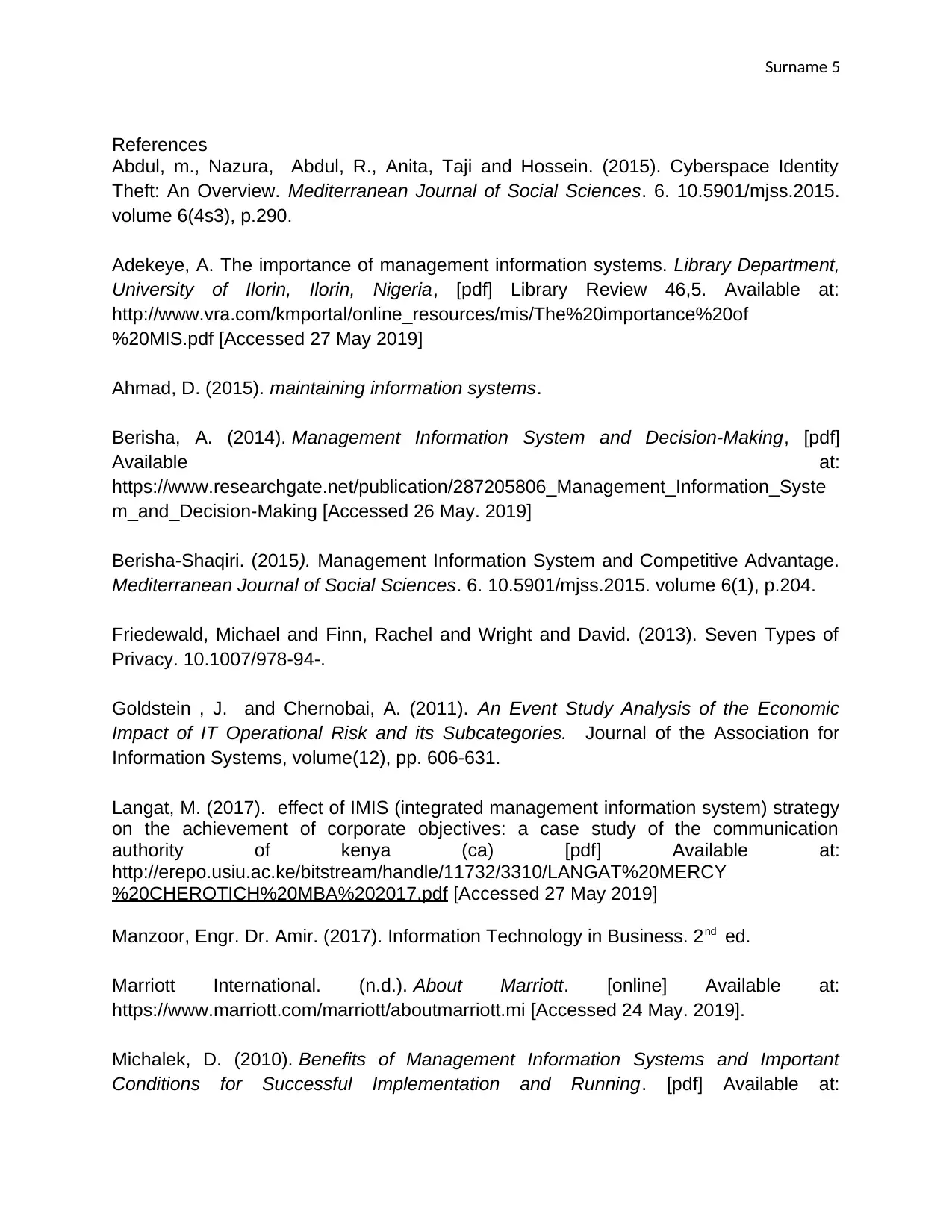
Surname 5
References
Abdul, m., Nazura, Abdul, R., Anita, Taji and Hossein. (2015). Cyberspace Identity
Theft: An Overview. Mediterranean Journal of Social Sciences. 6. 10.5901/mjss.2015.
volume 6(4s3), p.290.
Adekeye, A. The importance of management information systems. Library Department,
University of Ilorin, Ilorin, Nigeria, [pdf] Library Review 46,5. Available at:
http://www.vra.com/kmportal/online_resources/mis/The%20importance%20of
%20MIS.pdf [Accessed 27 May 2019]
Ahmad, D. (2015). maintaining information systems.
Berisha, A. (2014). Management Information System and Decision-Making, [pdf]
Available at:
https://www.researchgate.net/publication/287205806_Management_Information_Syste
m_and_Decision-Making [Accessed 26 May. 2019]
Berisha-Shaqiri. (2015). Management Information System and Competitive Advantage.
Mediterranean Journal of Social Sciences. 6. 10.5901/mjss.2015. volume 6(1), p.204.
Friedewald, Michael and Finn, Rachel and Wright and David. (2013). Seven Types of
Privacy. 10.1007/978-94-.
Goldstein , J. and Chernobai, A. (2011). An Event Study Analysis of the Economic
Impact of IT Operational Risk and its Subcategories. Journal of the Association for
Information Systems, volume(12), pp. 606-631.
Langat, M. (2017). effect of IMIS (integrated management information system) strategy
on the achievement of corporate objectives: a case study of the communication
authority of kenya (ca) [pdf] Available at:
http://erepo.usiu.ac.ke/bitstream/handle/11732/3310/LANGAT%20MERCY
%20CHEROTICH%20MBA%202017.pdf [Accessed 27 May 2019]
Manzoor, Engr. Dr. Amir. (2017). Information Technology in Business. 2nd ed.
Marriott International. (n.d.). About Marriott. [online] Available at:
https://www.marriott.com/marriott/aboutmarriott.mi [Accessed 24 May. 2019].
Michalek, D. (2010). Benefits of Management Information Systems and Important
Conditions for Successful Implementation and Running. [pdf] Available at:
References
Abdul, m., Nazura, Abdul, R., Anita, Taji and Hossein. (2015). Cyberspace Identity
Theft: An Overview. Mediterranean Journal of Social Sciences. 6. 10.5901/mjss.2015.
volume 6(4s3), p.290.
Adekeye, A. The importance of management information systems. Library Department,
University of Ilorin, Ilorin, Nigeria, [pdf] Library Review 46,5. Available at:
http://www.vra.com/kmportal/online_resources/mis/The%20importance%20of
%20MIS.pdf [Accessed 27 May 2019]
Ahmad, D. (2015). maintaining information systems.
Berisha, A. (2014). Management Information System and Decision-Making, [pdf]
Available at:
https://www.researchgate.net/publication/287205806_Management_Information_Syste
m_and_Decision-Making [Accessed 26 May. 2019]
Berisha-Shaqiri. (2015). Management Information System and Competitive Advantage.
Mediterranean Journal of Social Sciences. 6. 10.5901/mjss.2015. volume 6(1), p.204.
Friedewald, Michael and Finn, Rachel and Wright and David. (2013). Seven Types of
Privacy. 10.1007/978-94-.
Goldstein , J. and Chernobai, A. (2011). An Event Study Analysis of the Economic
Impact of IT Operational Risk and its Subcategories. Journal of the Association for
Information Systems, volume(12), pp. 606-631.
Langat, M. (2017). effect of IMIS (integrated management information system) strategy
on the achievement of corporate objectives: a case study of the communication
authority of kenya (ca) [pdf] Available at:
http://erepo.usiu.ac.ke/bitstream/handle/11732/3310/LANGAT%20MERCY
%20CHEROTICH%20MBA%202017.pdf [Accessed 27 May 2019]
Manzoor, Engr. Dr. Amir. (2017). Information Technology in Business. 2nd ed.
Marriott International. (n.d.). About Marriott. [online] Available at:
https://www.marriott.com/marriott/aboutmarriott.mi [Accessed 24 May. 2019].
Michalek, D. (2010). Benefits of Management Information Systems and Important
Conditions for Successful Implementation and Running. [pdf] Available at:
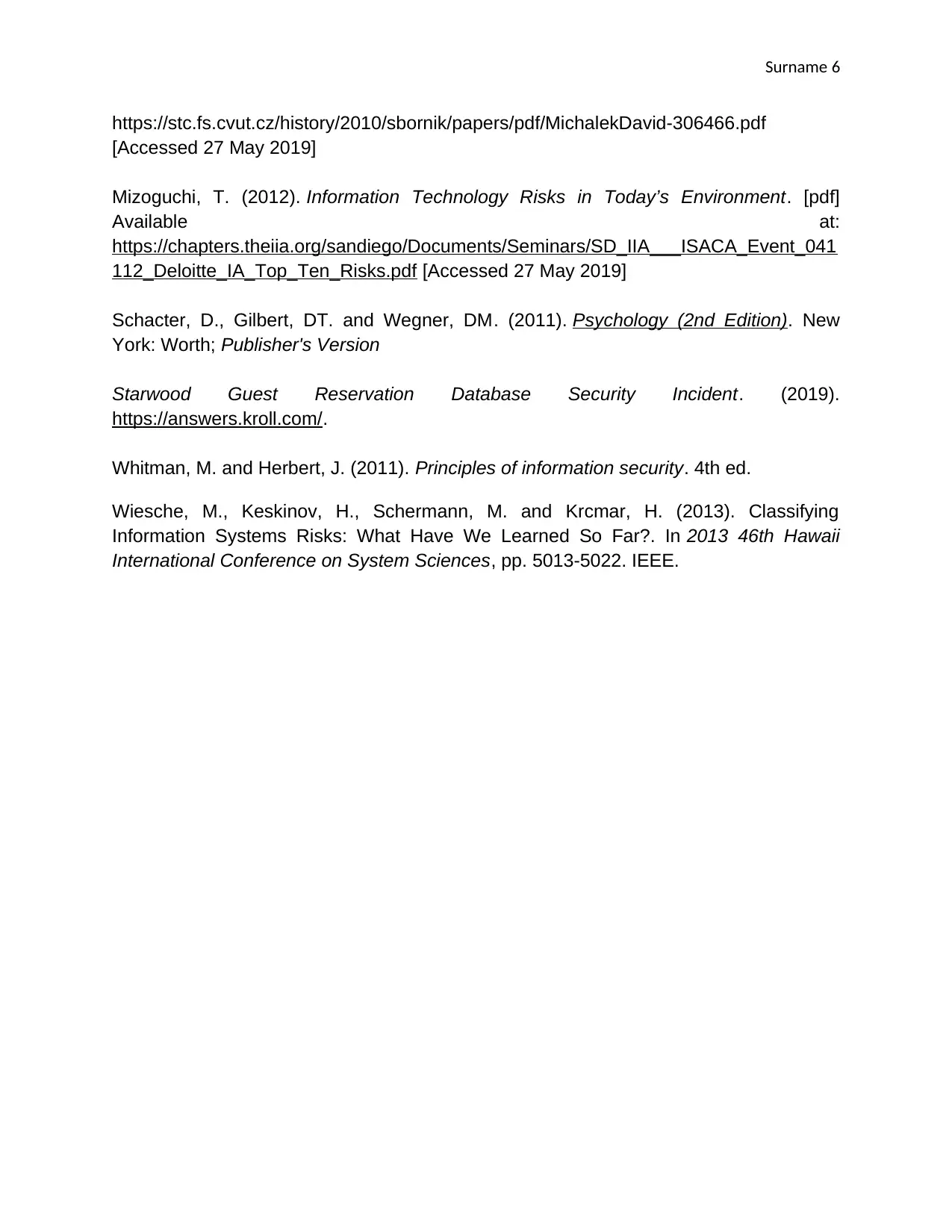
Surname 6
https://stc.fs.cvut.cz/history/2010/sbornik/papers/pdf/MichalekDavid-306466.pdf
[Accessed 27 May 2019]
Mizoguchi, T. (2012). Information Technology Risks in Today’s Environment. [pdf]
Available at:
https://chapters.theiia.org/sandiego/Documents/Seminars/SD_IIA___ISACA_Event_041
112_Deloitte_IA_Top_Ten_Risks.pdf [Accessed 27 May 2019]
Schacter, D., Gilbert, DT. and Wegner, DM. (2011). Psychology (2nd Edition). New
York: Worth; Publisher's Version
Starwood Guest Reservation Database Security Incident. (2019).
https://answers.kroll.com/.
Whitman, M. and Herbert, J. (2011). Principles of information security. 4th ed.
Wiesche, M., Keskinov, H., Schermann, M. and Krcmar, H. (2013). Classifying
Information Systems Risks: What Have We Learned So Far?. In 2013 46th Hawaii
International Conference on System Sciences, pp. 5013-5022. IEEE.
https://stc.fs.cvut.cz/history/2010/sbornik/papers/pdf/MichalekDavid-306466.pdf
[Accessed 27 May 2019]
Mizoguchi, T. (2012). Information Technology Risks in Today’s Environment. [pdf]
Available at:
https://chapters.theiia.org/sandiego/Documents/Seminars/SD_IIA___ISACA_Event_041
112_Deloitte_IA_Top_Ten_Risks.pdf [Accessed 27 May 2019]
Schacter, D., Gilbert, DT. and Wegner, DM. (2011). Psychology (2nd Edition). New
York: Worth; Publisher's Version
Starwood Guest Reservation Database Security Incident. (2019).
https://answers.kroll.com/.
Whitman, M. and Herbert, J. (2011). Principles of information security. 4th ed.
Wiesche, M., Keskinov, H., Schermann, M. and Krcmar, H. (2013). Classifying
Information Systems Risks: What Have We Learned So Far?. In 2013 46th Hawaii
International Conference on System Sciences, pp. 5013-5022. IEEE.
⊘ This is a preview!⊘
Do you want full access?
Subscribe today to unlock all pages.

Trusted by 1+ million students worldwide
1 out of 9
Related Documents
Your All-in-One AI-Powered Toolkit for Academic Success.
+13062052269
info@desklib.com
Available 24*7 on WhatsApp / Email
![[object Object]](/_next/static/media/star-bottom.7253800d.svg)
Unlock your academic potential
Copyright © 2020–2025 A2Z Services. All Rights Reserved. Developed and managed by ZUCOL.





